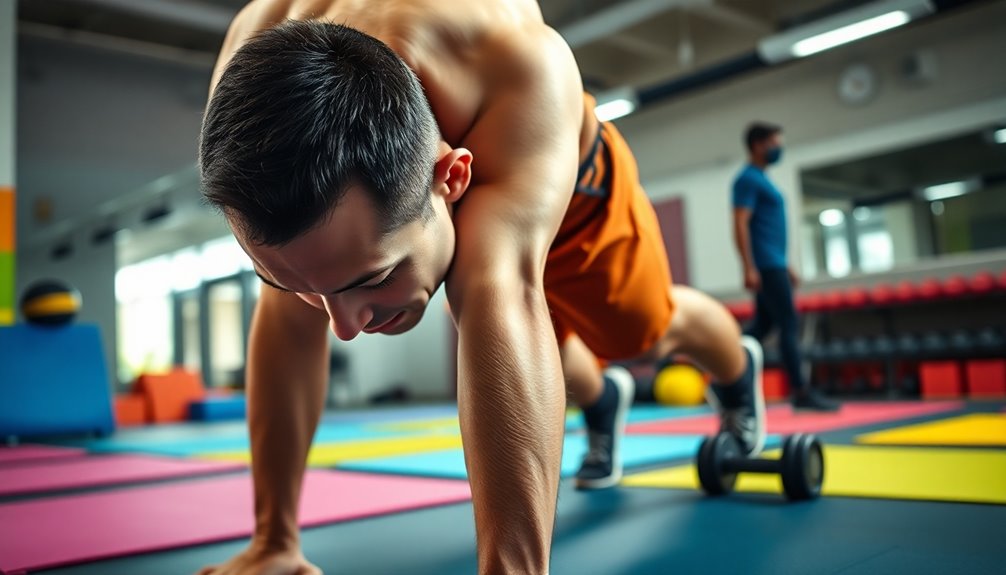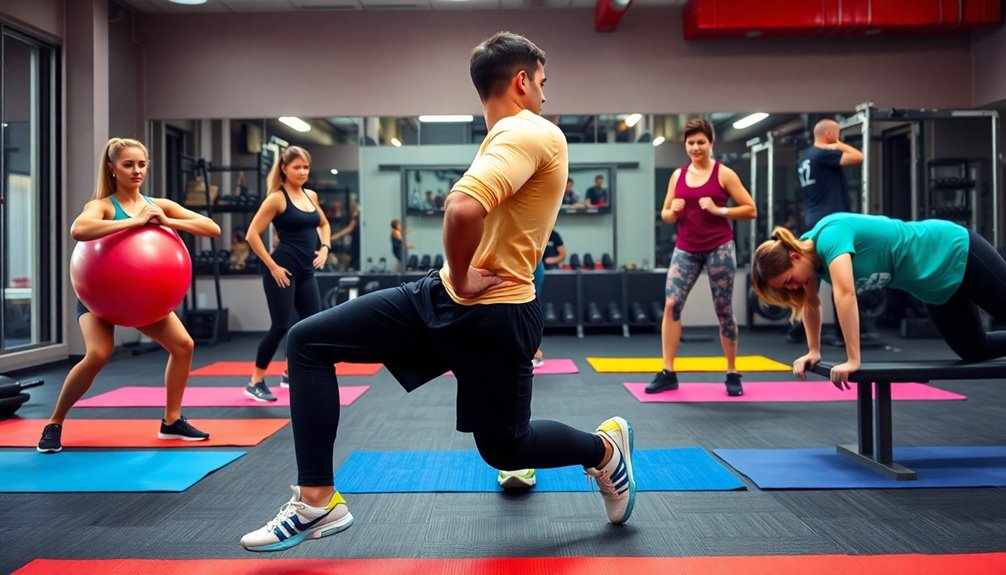In HIIT workouts, common mistakes can hold you back and lead to injuries. Don't skip your warm-ups; they're essential for preparing your body. Focus on proper form to guarantee safety and effectiveness. Remember recovery time is key—too much intensity without rest can lead to burnout. Stay hydrated and fuel with balanced meals to maximize your energy. Track your progress to motivate yourself and adjust your routines. Finally, don't hesitate to modify exercises to suit your level. By addressing these issues, you'll enhance your performance and enjoy a more engaging workout experience, and there's more valuable insight ahead.
Key Takeaways
- Skipping warm-ups can lead to injuries; always incorporate dynamic stretching to prepare your muscles and joints for HIIT workouts.
- Neglecting proper exercise form increases injury risk; seek feedback from trainers or experienced gym-goers to correct your technique.
- Ignoring recovery time can lead to overtraining; balance intense sessions with adequate rest and active recovery strategies.
- Underestimating nutrition and hydration hinders performance; fuel with carbs and protein pre-workout and stay hydrated throughout and after your session.
- Lack of exercise variety can cause plateaus; incorporate different intervals and modifications to keep workouts engaging and promote progress.
Skipping Warm-Up Routines

Skipping warm-up routines is one of the most common mistakes people make in HIIT workouts. It's easy to feel pumped and jump right into the heart-pounding action, but neglecting to warm up can lead to injuries and hinder your performance. You want to give your body the best chance to succeed, and that starts with proper technique—something a good warm-up can help establish.
Incorporating dynamic stretching into your warm-up is key. This type of stretching involves movement, preparing your muscles and joints for the intensity of HIIT. Instead of static stretches, think leg swings, arm circles, and walking lunges. These movements increase blood flow, enhance flexibility, and activate the muscles you'll rely on during your workout. Additionally, just like mini bands that provide effective muscle toning, warming up properly ensures your body is ready for the challenges ahead.
Taking just 5 to 10 minutes for this routine can make a significant difference in how you feel during your session.
Poor Exercise Form

When you push yourself through HIIT workouts, maintaining proper exercise form is crucial; otherwise, you risk not only diminishing your results but also increasing the chance of injury. It's easy to get caught up in the intensity and forget about your body's alignment. However, focusing on proper alignment during each movement ensures you're maximizing your efforts and staying safe.
To achieve effective HIIT sessions, pay attention to your technique. Whether you're performing burpees, squats, or mountain climbers, your form matters. If you notice your knees buckle during squats or your back rounds in push-ups, it's time for technique correction. Small adjustments can lead to significant improvements, helping you to engage the right muscles and avoid unnecessary strain.
Remember, you're part of a community striving for better health and fitness. Embrace the journey of learning and refining your movements. Don't hesitate to ask for feedback from trainers or fellow gym-goers. They can offer valuable insights that can help you correct your form and enhance your performance.
As you work on your alignment, keep in mind that it's not just about looking good—it's about feeling strong and confident in your body. By prioritizing proper exercise form, you'll not only achieve your fitness goals but also foster a sense of belonging within your workout community. Additionally, incorporating unique training strategies can further enhance your core strength and overall performance. So, take a moment to check in with your body, make the necessary adjustments, and watch your progress soar!
Ignoring Recovery Time

Even with perfect exercise form, neglecting recovery time can hinder your progress in HIIT workouts. You might feel tempted to push yourself harder, but remember, the significance of rest can't be overstated. Recovery time is essential for muscle repair, energy restoration, and overall performance improvement. Without adequate recovery, you risk injury and may find your progress stagnating. Additionally, incorporating scientific explanations about recovery can enhance your understanding of how rest impacts your HIIT performance.
Here are some effective recovery strategies to incorporate into your routine:
- Active Recovery: Engage in low-intensity exercises like walking or yoga on rest days to promote blood flow and keep your muscles loose.
- Hydration: Stay hydrated before, during, and after your workouts. Proper hydration aids in muscle recovery and overall performance.
- Nutrition: Fuel your body with a balanced diet rich in protein, healthy fats, and carbohydrates. Post-workout snacks can help replenish energy stores and repair muscles.
- Sleep: Prioritize quality sleep to allow your body to heal and rejuvenate. Aim for 7-9 hours of restful sleep each night.
Overtraining and Burnout

Overtraining and burnout can creep in silently, undermining your hard work and dedication in HIIT workouts. It's easy to push yourself too hard in pursuit of results, but recognizing burnout is essential for your long-term success. You want to feel energized and motivated, not exhausted and defeated.
To help you identify the signs of overtraining, here's a quick reference table:
| Signs of Overtraining | How to Address Them |
|---|---|
| Persistent fatigue | Incorporate rest days |
| Decreased performance | Adjust workout intensity |
| Increased irritability | Practice mindfulness |
| Sleeplessness | Establish a sleep routine |
| Frequent injuries | Listen to your body |
Preventing overtraining is all about balance. You need to mix intense sessions with recovery time, allowing your body to adapt and grow stronger. If you notice any signs of burnout, take a step back. Adjust your workout schedule, focus on lighter exercises, or even take a complete break if necessary. Additionally, incorporating a nutrition program focused on balanced meal planning can support your recovery and overall well-being.
Inadequate Hydration

Recovering from overtraining isn't merely about rest; hydration plays a significant role in your overall performance. When you engage in high-intensity interval training (HIIT), your body loses fluids rapidly, which can impact your strength and endurance. If you're not attentive to your hydration, you're setting yourself up for fatigue, decreased performance, and even injury.
To maintain peak performance, it's crucial to implement effective hydration strategies that support your workout routine. Here are some tips to keep in mind:
- Pre-Workout Hydration: Drink water or electrolyte-rich beverages before you head to the gym to prepare your body.
- During Workouts: Sip on fluids regularly throughout your session to replenish lost liquids.
- Post-Workout Replenishment: Rehydrate after your workout with water or a sports drink to restore electrolyte balance.
- Daily Water Intake: Aim for a consistent daily water intake to bolster your overall health and energy levels.
Additionally, chronic dehydration can lead to chronic high blood pressure, further complicating your recovery and performance.
Not Modifying Exercises

Many people immerse themselves in HIIT workouts without considering the significance of modifying exercises to fit their individual fitness levels. It's easy to get caught up in the intensity and excitement of a group setting, but remember, everyone's journey is different. Not making necessary exercise modifications can lead to frustration, injury, and burnout.
You owe it to yourself to prioritize your well-being by adjusting exercises to match your current capabilities. If a jump squat feels too challenging, swap it out for a bodyweight squat. If you're struggling with burpees, try stepping back instead of jumping. These adjustments are crucial for ensuring that you can maintain proper form and get the most out of your workout.
Proper progressions are essential in any fitness routine. Start with foundational movements before advancing to more complex exercises. This approach not only builds your strength and endurance but also boosts your confidence. Remember that weak glutes can hinder your performance and increase the risk of injury, so incorporating glute-specific training is beneficial as you progress.
As you become more comfortable with modified versions, gradually increase the intensity or complexity of the exercises.
Don't hesitate to communicate with your coach or workout group about your needs. A supportive community will understand that modification is a sign of strength, not weakness. Embrace your unique fitness journey, and remember that every small step forward counts.
Lack of Progress Tracking

A common oversight in HIIT workouts is the lack of progress tracking, which can hinder your fitness journey. When you don't monitor your improvements, it's tough to stay motivated and committed. You might feel like you're putting in all this effort without reaping the rewards. By setting goals and tracking results, you can witness your growth and feel a sense of accomplishment.
Here are some effective ways to enhance your progress tracking:
- Set Specific Goals: Define what you want to achieve, whether it's increasing your workout duration or more reps in a set time.
- Record Your Workouts: Keep a journal or use an app to note down your exercises, duration, and intensity.
- Take Measurements: Regularly measure your body metrics, like weight or body fat percentage, to see tangible results.
- Reflect and Adjust: Set aside time to review your progress. If something isn't working, tweak your approach and set new goals.
Additionally, incorporating progress tracking tools can streamline your efforts and keep you accountable on your fitness journey.
Focusing Solely on Intensity

One major mistake people make in HIIT workouts is focusing solely on intensity. While pushing yourself is essential, neglecting other vital elements can lead to burnout or injury. You might feel the urge to go all out every session, but remember that proper rest and exercise variety are pivotal for long-term success.
Here's a quick guide to balance intensity with other necessary aspects of HIIT:
| Focus Area | Why It Matters | How to Implement |
|---|---|---|
| Intensity | Boosts cardiovascular fitness | Alternate high/low intervals |
| Proper Rest | Prevents overtraining | Schedule rest days |
| Exercise Variety | Keeps workouts engaging and effective | Mix in different exercises |
Incorporating proper rest allows your body to recover and rebuild, making you stronger over time. It's tempting to skip rest days, but doing so can hinder your progress. Likewise, exercise variety keeps your routine fresh and exciting. You're more likely to stick with your workouts when they're enjoyable, and mixing things up helps prevent plateaus. Additionally, incorporating pre-habilitation techniques can enhance your performance and reduce the risk of injury.
Neglecting Nutrition

Neglecting nutrition is a common pitfall in HIIT workouts that can greatly hinder your progress. While you might be pushing yourself through those intense sessions, remember that what you fuel your body with plays an equally essential role in achieving your fitness goals.
To maximize your HIIT results, focus on maintaining a nutritional balance and pay attention to macronutrient timing.
Here are some key points to highlight:
- Pre-Workout Fuel: Eat a balanced meal 1-2 hours before your workout, including carbs and protein to provide energy.
- Post-Workout Recovery: Consume a protein-rich snack or meal within 30 minutes of finishing your session to aid muscle recovery.
- Hydration: Stay hydrated before, during, and after your workouts. Dehydration can sap your performance and recovery.
- Whole Foods: Prioritize whole, nutrient-dense foods over processed options to support your overall health and energy levels. A plant-based diet is rich in antioxidants and fiber which can further enhance your performance and recovery.
Frequently Asked Questions
How Do I Choose the Right HIIT Workout for My Fitness Level?
To choose the right HIIT workout for your fitness level, start by evaluating your current abilities. You want to match the HIIT workout intensity to what you can handle. Don't hesitate to modify exercises; tailoring HIIT exercises guarantees you stay challenged yet safe.
Begin with shorter intervals and gradually increase duration as you become more comfortable. Remember, it's all about progress, and you'll feel empowered as you push your limits!
Can HIIT Workouts Be Done at Home Effectively?
Absolutely, you can do HIIT workouts at home effectively! The benefits include convenience and the ability to tailor sessions to your fitness level. While there are drawbacks, like limited space and equipment, you can still achieve great results. Just focus on safety—use proper form and start slow. With consistency, you'll see effectiveness in no time.
Embrace the challenge; you're part of a community working towards better health together!
What Equipment Do I Need for HIIT Workouts?
When it comes to HIIT workouts, think of your equipment as the paintbrushes to your masterpiece. You don't need a lot; for budget options, grab a sturdy mat, resistance bands, and some dumbbells.
If you're ready to elevate your game, consider advanced options like kettlebells, a jump rope, or a medicine ball. With the right HIIT equipment, you'll feel empowered to push boundaries and achieve your fitness goals, all while belonging to a vibrant community.
How Often Should I Incorporate HIIT Into My Weekly Routine?
To get the most out of your HIIT workouts, aim for two to three sessions per week. This frequency strikes the right balance between intensity and proper recovery, allowing your body to adapt and strengthen.
Consistency is key, so find a schedule that works for you. Remember, it's okay to adjust based on how you feel. Listening to your body will help you stay motivated and engaged in your fitness journey.
Are There Specific HIIT Workouts for Weight Loss vs. Muscle Gain?
Are you ready to transform your body? When it comes to HIIT, workouts can vary depending on your goals. For weight loss, focus on HIIT for beginners, incorporating high-intensity cardio and shorter rest periods. If you're an athlete, your HIIT should emphasize strength and endurance, with more complex movements. Tailor your routine to suit your needs, and you'll see amazing results. Stay committed, and you'll find your place in the fitness community!
Conclusion
As you lace up your sneakers and step onto the mat, remember that every drop of sweat counts, but so does your well-being. Avoiding common HIIT pitfalls can transform your workout from a struggle to a triumph. Picture yourself thriving with energy, embracing recovery, and fueling your body with the right nutrition. By prioritizing form, hydration, and balance, you're not just pushing limits; you're crafting a stronger, healthier you. Let each session be a celebration of your progress!



